CR Batteries
Heat Resistant Coin Type Lithium Manganese Dioxide Battery
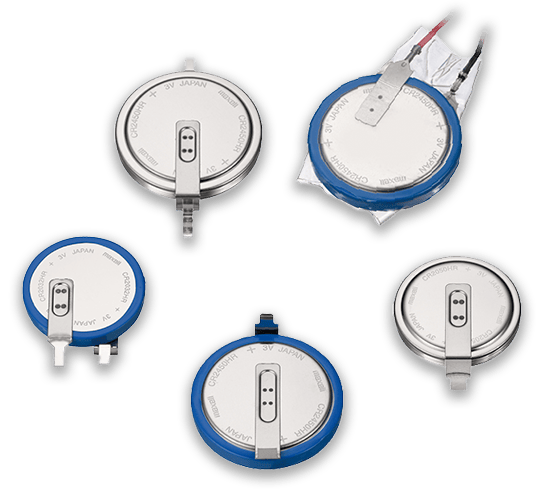
Maxell’s original sealing technology and highly heat-resistant material expands operating temperature range remarkably, making the batteries supremely suitable for automobile applications — for powering TPMS (Tire Pressure Monitoring System) sensors, for example.
The range of technologies where these batteries can be applied is expanding to include IoT sensors and HACCP temperature loggers that require a wide operating temperature range.
About Maxell Heat Resistant CR batteries
UL Recognized Components
The heat resistant coin type lithium manganese dioxide battery is a UL (Underwriters Laboratories Inc.) recognized component. (Technician Replaceable)
Recognized model: CR2450HR, CR2450HR-Ex, CR2050HR, CR2032HR, CR2032HRS
Certification Number: MH12568
Applications
- TPMS (Tire-Pressure Monitoring System)
- ETC (Electronic Toll Collection systems)
- Keyless entry systems
- Seat location sensors
- Communication tags, Beacons
- Temperature data loggers (HACCP temperature loggers)
- Logistics tags
- FA instruments (Measuring instruments, Onboard microcomputers, Sensors)
- IoT sensors
- Wide Operating Temperature range: -40 deg. C to +125 deg. C*
CR2450HR-Ex batteries can even be used at temperatures up to 150 deg. C, depending on other conditions.
*When using at temperatures exceeding 85 deg. C, please consult Maxell in advance for conditions of use. - Superior leak-resistant characteristics even under high temperature and acceleration.
- Can be used even under 2000G, which is equivalent to driving at 300km/h.
- Electric characteristics are maintained after long periods of exposure to high temperature and humidity.
Specifications
| Model | CR2032HR | CR2050HR | CR2450HR | CR2450HR-Ex | |
|---|---|---|---|---|---|
| Nominal Voltage (V) | 3 | 3 | 3 | 3 | |
| Nominal Capacity (mAh) *1 | 200 | 350 | 550 | 525 | |
| Nominal Discharge Current (mA) | 0.2 | 0.2 | 0.2 | 0.2 | |
| Operating Temperature Range (deg. C) *2 | -40 to +125 |
-40 to +125 (max.150) |
|||
| Acceleration Resistance | Max. 2000G *3 | ||||
| Dimensions *4 | Diameter(mm) | 20.0 | 20.0 | 24.5 | 24.5 |
| Height(mm) | 3.2 | 5.0 | 5.0 | 5.0 | |
| Weight(g) *4 | 3.0 | 4.1 | 6.8 | 6.8 | |
| Data Sheets |
|
|
|
|
|
| With Terminals |
|
|
|
- | |
| Warnings |
|
||||
- Nominal capacity indicates duration until the voltage drops down to 2.0V when discharged at a nominal discharge current at 20 deg. C.
- When using these batteries at temperatures exceeding 85 deg. C, please consult Maxell in advance for conditions of use.
- Equivalent to acceleration when driving at 300km/h, when attached to a 17-inch wheel.
- Dimensions and weight are for the battery itself, but may vary depending on terminal specifications and other factors.
- Data and dimensions are not guaranteed. For further details, please contact us at your nearest Maxell office.
- Contents on this website are subject to change without notice.
Construction
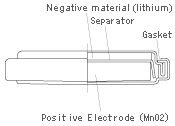
Principle and Reactions
The coin type lithium manganese dioxide battery uses manganese dioxide (MnO2) as its positive active material, lithium (Li) as its negative active material and an organic electrolyte.
| Positive reaction : | MnO 2 +Li + +e - → MnOOLi |
|---|---|
| Negative reaction : | Li → Li + +e - |
| Total reaction : | MnO 2 +Li → MnOOLi |
Storage Characteristics under High Temperatures
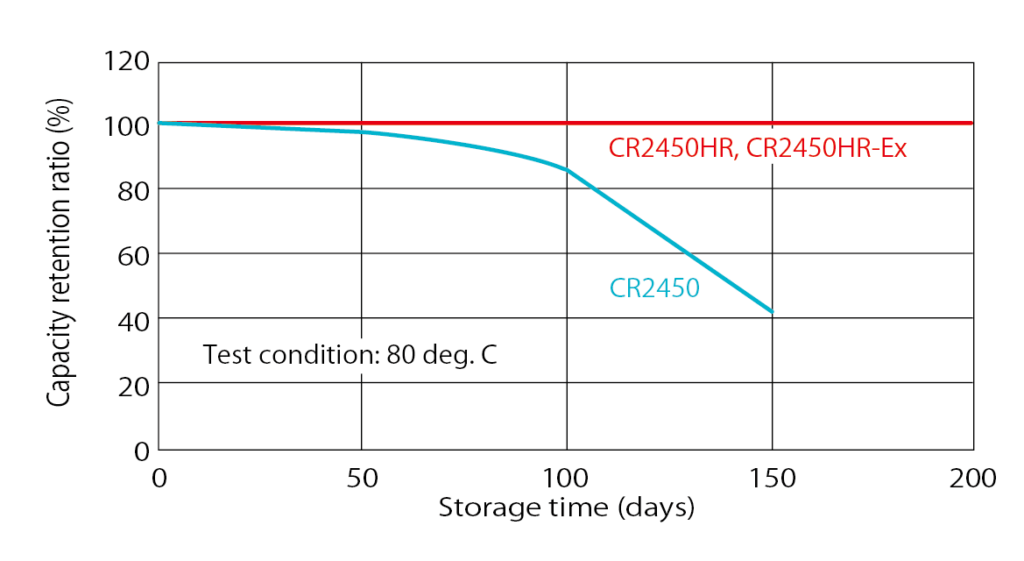
Little deterioration in capacity due to high storage temperature of 80 deg. C, compared to CR2450 battery.
Storage Characteristics under High Temperature/Humidity
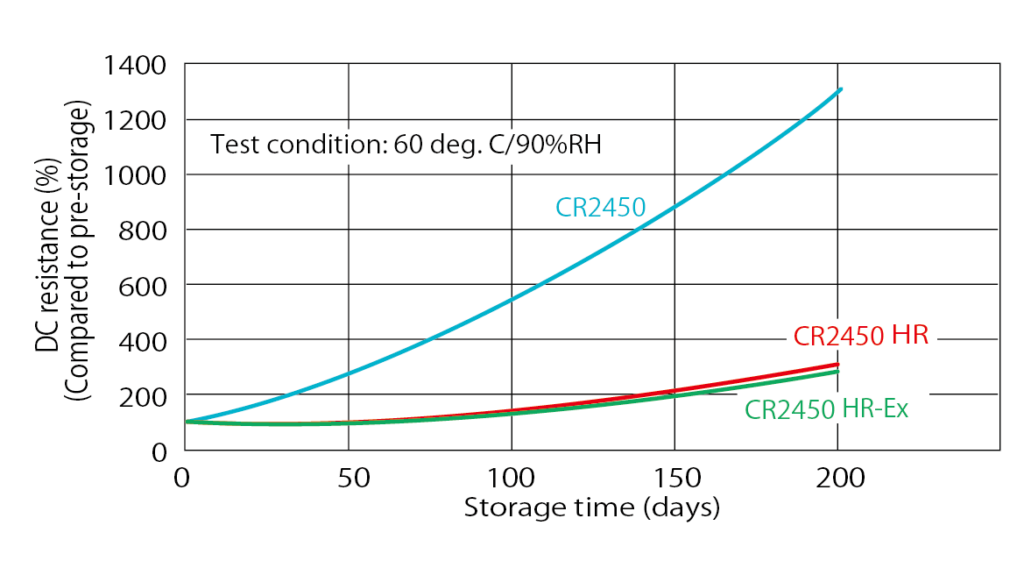
Discharge Characteristics
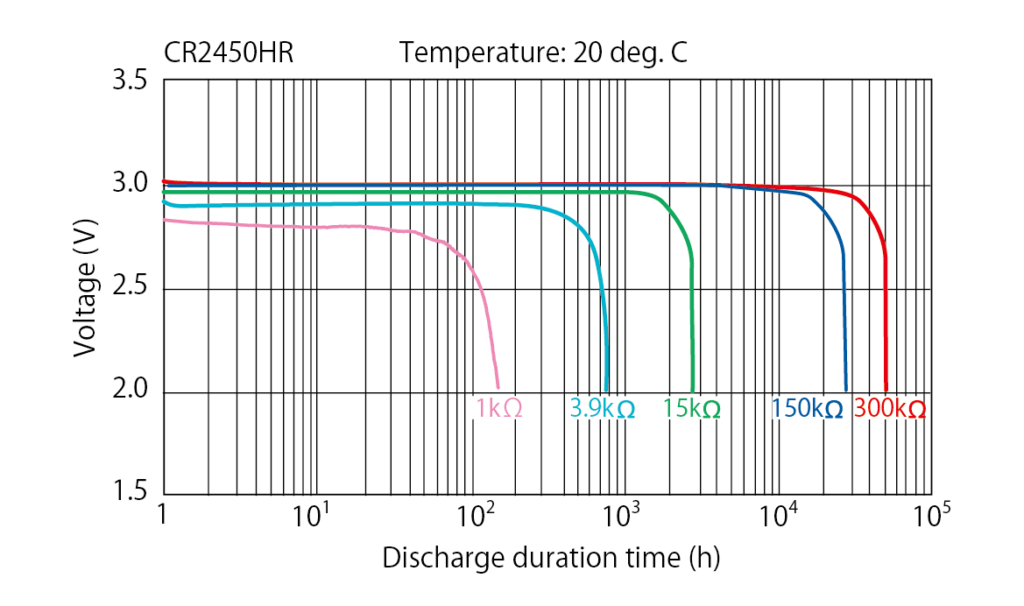
Temperature Characteristics
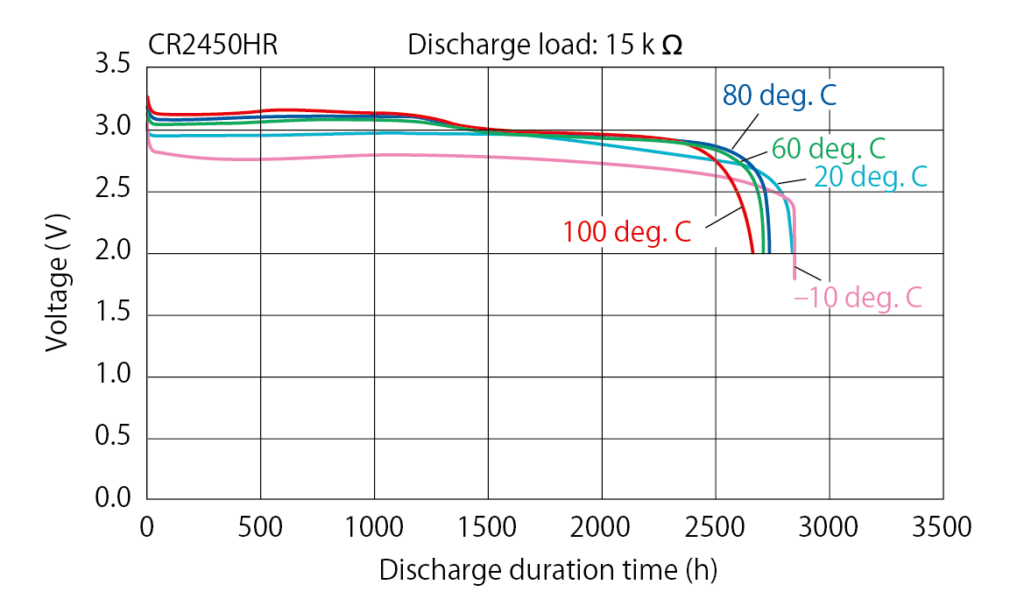
Safety precautions
If misused, this battery may deform, leak (the liquid inside the battery may leak to the outside), generate heat, explode, or ignite.
Since such misuse may cause injury or equipment failure, please be sure to read and observe [Warnings and Cautions].
Glossary of Battery Terms
Direct contact electrically between the positive electrode and negative electrode caused by damage to the separator or gasket, or the presence of a conductor piercing the separators. A battery will become completely exhausted before use.
Surges of current across the terminals of a battery when it is short-circuited.
Enduring characteristics against leakage.
Ratio of usable capacity against theoretical capacity.
Medium in a battery which causes ions to move to create an electrochemical reaction. Either water or non-aqueous solution is used as solvent. The latter is called non-aqueous electrolyte solution, either organic or inorganic.
Electrode materials in a battery which cause an electrochemical reaction to generate electricity.
Ex)
Battery Type / Positive material / Negative material
LR / Manganese Dioxide / Zinc
CR / Manganese Dioxide / Lithium
Expiration of guarantee period of a primary battery determined by each manufacturer conforming to the IEC. Because a secondary battery can be used over again by charging, it is unnecessary to show this.
Note: IEC (International Electrotechnical Commission) is a worldwide organization of standardization comprised of all national electrotechnical committees.
A finished or semi-finished battery is store under specified conditions for a specified period.
Test conducted within 2 weeks after storage.
Store the battery under specified conditions.
Test conducted within 2 months of the production month.
Usable energy of a battery per unit volume or unit weight. The former is called volumetric energy density (Wh/l); the latter gravimetric energy density (Wh/kg).
Capacity (Ah, mAh) is the product of the discharge current (A, mA) and discharge time (h). Note: Because manganese dry batteries and alkaline manganese batteries are often used for heavy-duty applications, the discharge time at a specific load is usually mentioned instead of the capacity.
Time until a battery voltage exceeds the end-point voltage during discharge.
Voltage deviation from equilibrium caused by charge or discharge.
Operation during which a reverse reaction of discharge occurs when electrical energy is received from an external source.
Change of a battery voltage with discharge.
Decreasing capacity during storage without load, caused by chemical reaction in a battery. The higher the temperature during storage, the greater the rate of self discharge.
Continue to discharge after a battery voltage drops below its end-point voltage.
Operation during which a battery delivers current to an external circuit.
Resistant component in a battery that makes discharge reaction slow.
Specified closed circuit voltage at which a service output test is terminated.
External device or method through which a battery is discharged.
Suitable approximate value of voltage used to identify the voltage of a battery.
For example)
Alkaline manganese battery; 1.5V
Lithium manganese dioxide battery; 3.0V
Voltage across the terminals of a battery when it is on discharge. As a battery has an internal resistance, CCV is lower than OCV and CCV becomes lower with a range of current.
Voltage across the terminals of a battery when no external current is flowing.
Source of electrical energy obtained by the direct conversion of chemical energy designed to be charged by any other electrical source. It is also called a storage battery or accumulator.
Source of electrical energy obtained by the direct conversion of chemical energy and not designed to be charged by any other electrical source.
Download Links
Downloads
Contact Us
If you think CR Batteries might be of interest for your project and you need some more information, please complete the form below and someone will get in contact with you shortly.

